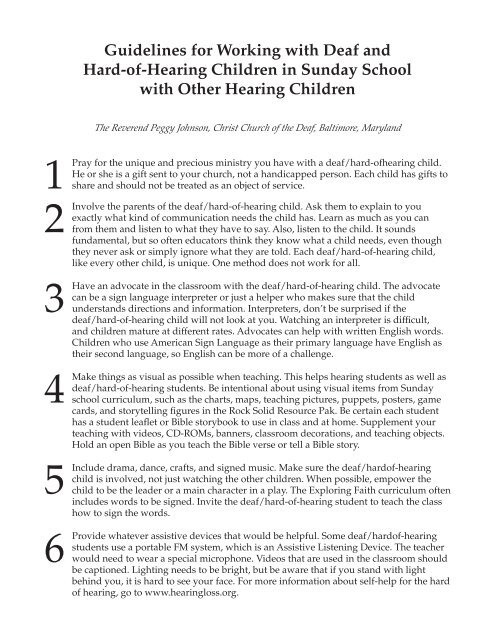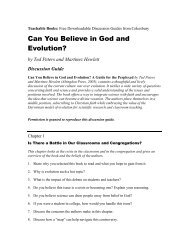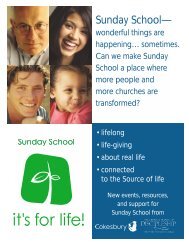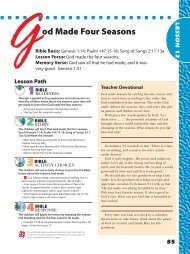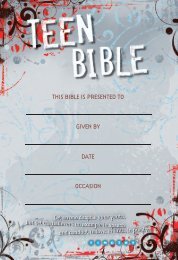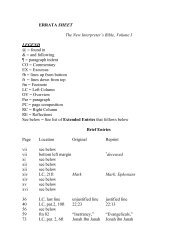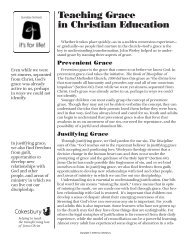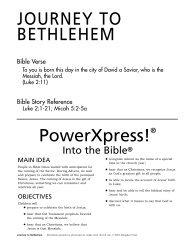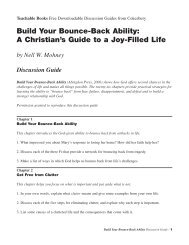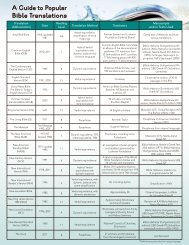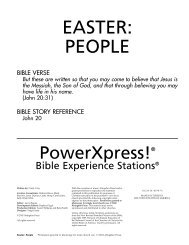Guidelines for Working with Deaf and Hard-of-Hearing ... - Cokesbury
Guidelines for Working with Deaf and Hard-of-Hearing ... - Cokesbury
Guidelines for Working with Deaf and Hard-of-Hearing ... - Cokesbury
You also want an ePaper? Increase the reach of your titles
YUMPU automatically turns print PDFs into web optimized ePapers that Google loves.
<strong>Guidelines</strong> <strong>for</strong> <strong>Working</strong> <strong>with</strong> <strong>Deaf</strong> <strong>and</strong><br />
<strong>Hard</strong>-<strong>of</strong>-<strong>Hearing</strong> Children in Sunday School<br />
<strong>with</strong> Other <strong>Hearing</strong> Children<br />
The Reverend Peggy Johnson, Christ Church <strong>of</strong> the <strong>Deaf</strong>, Baltimore, Maryl<strong>and</strong><br />
1<br />
Pray<br />
2<br />
Involve<br />
3<br />
Have<br />
4<br />
Make<br />
5<br />
Include<br />
6<br />
Provide<br />
<strong>for</strong> the unique <strong>and</strong> precious ministry you have <strong>with</strong> a deaf/hard-<strong>of</strong>hearing child.<br />
He or she is a gift sent to your church, not a h<strong>and</strong>icapped person. Each child has gifts to<br />
share <strong>and</strong> should not be treated as an object <strong>of</strong> service.<br />
the parents <strong>of</strong> the deaf/hard-<strong>of</strong>-hearing child. Ask them to explain to you<br />
exactly what kind <strong>of</strong> communication needs the child has. Learn as much as you can<br />
from them <strong>and</strong> listen to what they have to say. Also, listen to the child. It sounds<br />
fundamental, but so <strong>of</strong>ten educators think they know what a child needs, even though<br />
they never ask or simply ignore what they are told. Each deaf/hard-<strong>of</strong>-hearing child,<br />
like every other child, is unique. One method does not work <strong>for</strong> all.<br />
an advocate in the classroom <strong>with</strong> the deaf/hard-<strong>of</strong>-hearing child. The advocate<br />
can be a sign language interpreter or just a helper who makes sure that the child<br />
underst<strong>and</strong>s directions <strong>and</strong> in<strong>for</strong>mation. Interpreters, don’t be surprised if the<br />
deaf/hard-<strong>of</strong>-hearing child will not look at you. Watching an interpreter is difficult,<br />
<strong>and</strong> children mature at different rates. Advocates can help <strong>with</strong> written English words.<br />
Children who use American Sign Language as their primary language have English as<br />
their second language, so English can be more <strong>of</strong> a challenge.<br />
things as visual as possible when teaching. This helps hearing students as well as<br />
deaf/hard-<strong>of</strong>-hearing students. Be intentional about using visual items from Sunday<br />
school curriculum, such as the charts, maps, teaching pictures, puppets, posters, game<br />
cards, <strong>and</strong> storytelling figures in the Rock Solid Resource Pak. Be certain each student<br />
has a student leaflet or Bible storybook to use in class <strong>and</strong> at home. Supplement your<br />
teaching <strong>with</strong> videos, CD-ROMs, banners, classroom decorations, <strong>and</strong> teaching objects.<br />
Hold an open Bible as you teach the Bible verse or tell a Bible story.<br />
drama, dance, crafts, <strong>and</strong> signed music. Make sure the deaf/hard<strong>of</strong>-hearing<br />
child is involved, not just watching the other children. When possible, empower the<br />
child to be the leader or a main character in a play. The Exploring Faith curriculum <strong>of</strong>ten<br />
includes words to be signed. Invite the deaf/hard-<strong>of</strong>-hearing student to teach the class<br />
how to sign the words.<br />
whatever assistive devices that would be helpful. Some deaf/hard<strong>of</strong>-hearing<br />
students use a portable FM system, which is an Assistive Listening Device. The teacher<br />
would need to wear a special microphone. Videos that are used in the classroom should<br />
be captioned. Lighting needs to be bright, but be aware that if you st<strong>and</strong> <strong>with</strong> light<br />
behind you, it is hard to see your face. For more in<strong>for</strong>mation about self-help <strong>for</strong> the hard<br />
<strong>of</strong> hearing, go to www.hearingloss.org.
7<br />
For<br />
8<br />
Be<br />
9<br />
H<strong>and</strong>le<br />
deaf/hard-<strong>of</strong>-hearing children who are lip readers, be sure to face them when you<br />
speak; turning to write on the chalkboard while you talk cuts <strong>of</strong>f communication. Do<br />
not cover your mouth or chew gum. Rephrase a sentence if the child cannot underst<strong>and</strong><br />
it; sometimes the rephrased version is more underst<strong>and</strong>able on the lips. Speak clearly<br />
<strong>and</strong> distinctly, but do not overly mouth the words or shout.<br />
warm, genuine, <strong>and</strong> loving. Love communicates faith better than any lesson, <strong>and</strong> it<br />
transcends all language barriers.<br />
questions from hearing students about the deaf/hard-<strong>of</strong>-hearing child directly<br />
<strong>and</strong> matter-<strong>of</strong>-factly. Encourage respect <strong>and</strong> kindness. Explain what a hearing aid or<br />
cochlear implant is simply <strong>and</strong> <strong>with</strong>out making a big deal about it. (A cochlear implant<br />
is an electronic hearing aid that is a replacement <strong>of</strong> part or all <strong>of</strong> the function <strong>of</strong> the inner<br />
ear.) Don’t ignore the questions, but move on <strong>with</strong>out belaboring the issue.<br />
PEGGY JOHNSON, pastor at Christ Church <strong>of</strong> the <strong>Deaf</strong> in Baltimore, Maryl<strong>and</strong>, has been<br />
teaching religious education in a deaf school <strong>for</strong> 23 years. If you have questions, you<br />
may contact Peggy, who is a consultant <strong>for</strong> the National Committee on <strong>Deaf</strong> Ministry,<br />
at RevPink@aol.com or at 410- 247-5045 V/TTY.<br />
Copyright © 2003 <strong>Cokesbury</strong>. All rights reserved. This downloadable resource is <strong>of</strong>fered free <strong>of</strong> charge by <strong>Cokesbury</strong>.<br />
Additional copies may be made <strong>with</strong>out permission <strong>of</strong> the publisher. For additional in<strong>for</strong>mation, call Curric-U-Phone<br />
toll free at 1-800-251-8591 or send e-mail to curricuphone@cokesbury.com.


